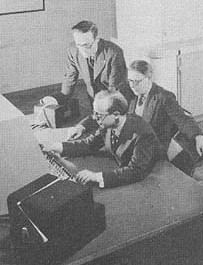- unknown (b.)
Bio/Description
During the 1950s, under his direction, the Gorton labs also researched magnetic amplifiers. Like most teams, they decided to abandon them when transistors improved. The Ferranti Computer Department in West Gorton Manchester had originally been set up as an industrial partner of Manchester University's pioneering computer research lab, commercializing their Manchester Mark 1 and several follow-on designs. One member of the lab, Ken Johnson, proposed a new type of transistor-based logic that followed the same conventions as the magnetic amplifiers, namely that binary logic was based on known currents instead of voltages. Like the magnetic amplifiers, Johnson's "Neuron" design could be used to control several different inputs. Better yet, the system often required only one transistor per logic element, whereas conventional voltage-based logic would require two or more. Although transistors were falling in price they were still expensive, so a Neuron based machine might offer similar performance at a much lower price than a machine based on traditional transistor logic. The team decided to test the Neuron design by building a small machine known as "Newt", short for "Neuron test". This machine was so successful that the lab decided to expand the testbed into a complete computer. The result was the Sirius, which was announced on 19 May 1959 with claims that it was the smallest and most economically priced computer in the European market. Several sales followed. With the success of Sirius, the team turned its attention to a much larger design. Since many of the costs of a complete computer system are fixed - power supplies, printers, etc. - a more complex computer with more internal circuitry would have more of its cost associated with the circuits themselves. For this reason, a larger machine made of Neurons would have an increased price advantage over transistorized offerings. He decided that such a machine would be a strong counterpart to the high-end Atlas, and would form the basis for Ferranti's sales for the next five years. Looking for a launch customer, Ferranti signed up Prudential Assurance with the promise to deliver the machine in 1960. However, these plans quickly went awry. The Neuron proved unable to be adapted to the larger physical size of the Orion. Keeping the current levels steady over the longer wire runs was extremely difficult, and efforts to cure the problems resulted in lengthy delays. The first Orion was eventually delivered, but was over a year late and unit cost was more than expected, limiting its sales. Between 1962 and 1964 the Computing Division lost $7.5 million, largely as a result of the Orion. During the Orion's gestation it appeared there was a real possibility the new system might not work at all. Engineers at other Ferranti departments, notably the former Lily Hill House in Bracknell, started raising increasingly vocal concerns about the effort. Several members from Bracknell approached Gordon Scarrott and tried to convince him that Orion should be developed using an all-transistor design. They recommended using the "Griblons" circuits developed by Maurice Gribble at Ferranti's Wythenshawe plant, which they had used to successfully implement their Argus computer for the Bristol Bloodhound missile system. Their efforts failed, and they turned to him to overrule Scarrott, which led to a series of increasingly acrimonious exchanges. After their last attempt on 5 November 1958, they decided to go directly to Sebastian de Ferranti, but this effort also failed.He resigned about a month later and his position was taken over by Peter Hall. Braunholtz who later expressed his frustration that they didn't write to him directly, and the matter sat for several years while Orion continued to run into delays. In September 1961 Prudential was threatening to cancel their order, and by chance, Braunholtz at that moment sent a telegram to Hall expressing his continuing concerns. Hall immediately invited Braunholtz to talk about his ideas, and several days later the Bracknell team was working full out on what would become the Orion 2. In ?Turing?s Cathedral? by George Dyson he is in a photo with Alan Turing and Keith Lonsdale at the console of the Ferranti Mark 1 computer at the University of Manchester in 1951.
-
Gender:
Male -
Noted For:
A member of a team whose research developed the Sirius, which in 1959 claimed that it was the smallest and most economically priced computer in the European market -
Category of Achievement:
-
More Info:


